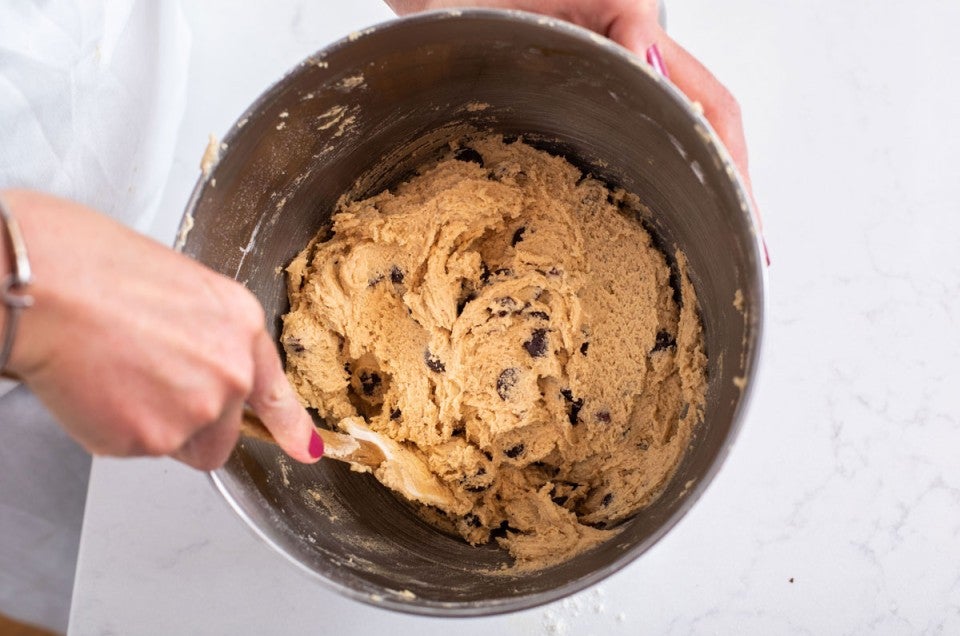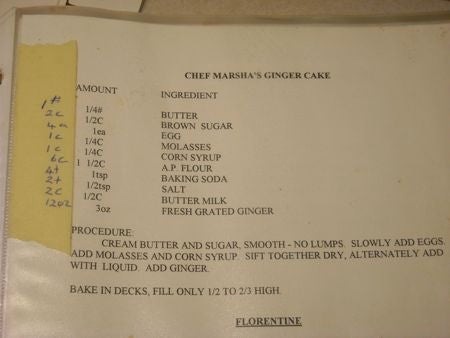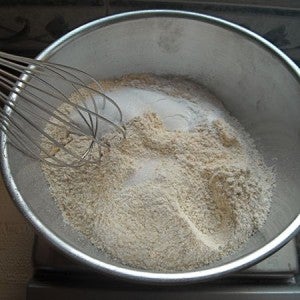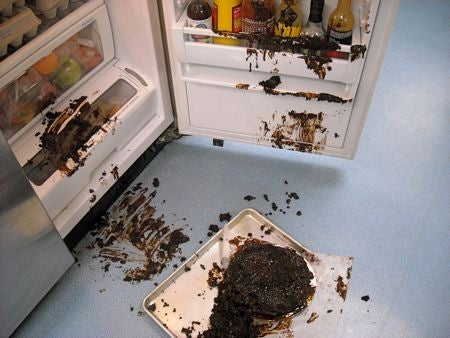Forgot the sugar in your cake? Here's how to save your baked goods.
Backing up from the inevitable boo-boo.


“I am putting in the yeast, NOW!”
“Testify, sister!!”
No, it’s not religious revival, it’s another day in the test kitchen.
Every one of us in the test kitchen has done it more than once. We mix and knead everything together, go away for an hour or more, and come back to see that our dough has done… nothing. We wonder, “Did I add the yeast? If I did add the yeast, is it dead?”
Thus we developed the call and response technique. We sing out as the yeast goes into the bowl or machine, and by outwardly affirming our action, have more confidence that it actually happened.
Have you ever been a victim of yeast forgetfulness? Fear not, you can fix this. All it takes is time. If you’re using active dry yeast, put the amount the recipe calls for into 3 tablespoons of tepid water and wait 5 minutes. If it starts to bubble, add the slurry to your dough and mix until the dough is smooth again.
As it happens, about 10 minutes ago I got a plaintive phone call from Mary Jane. She'd made some pizza dough for her family's supper on her break. Four hours later, she called and said, "Can you do me a favor?" Her bag of dough had no bubbles in it; a sure sign that the magic ingredient was left behind. She couldn't leave her desk, so I've plopped MJ's dough into my bread machine, added the yeast, and it's twirling around right now. By the time MJ is ready to leave, she'll put it back in the bag, and after her drive home it will be ready to be shaped.
In either case, if you add yeast after the fact, you’ll have to give the dough its first rise all over again. If it’s too late in the day to have any hope of finishing the bread before midnight, let the dough rise at room temperature for half an hour (enough to have some confidence that it’s moving), then refrigerate it overnight and finish the recipe the next day.
Since I started working on this subject (an excellent suggestion reader from Ellen Davis), EVERY SINGLE THING I’ve baked has had some kind of mistake in it. My colleagues are telling me that my subconscious is working, “helping” me flesh out the topic. It’s certainly helped with the photo-taking…
Here's a prime example: I forgot the vanilla in the dough above and decided to see if a schmear of vanilla paste would do the trick. Results? Not bad, but not great either. That's why they call it a mistake.
The perfectly organized baker would check off every ingredient in a recipe as it gets added, so nothing would ever be left out. I used to train culinary students to put their recipes in plastic sleeves, and put a piece of masking tape on the sleeve next to the ingredients. That way they could convert a recipe up or down and check off the ingredients as they were added.

This is a good thing to do when teaching kids how to bake. They learn to organize themselves and get a chance to give math a hands-on workout. But you know the saying about those who can, and those who can't ...
Forget the sugar in a cake or quick bread? I’ve done this more times than I care to admit, especially when I was testing 10 or more recipes at a time for our Whole Grain Baking cookbook. The first hint is the look of the batter. If it seems way too thick, taste a tiny bit. You’ll know right away if the sugar was left out.
This caramel cake batter is a perfect example. It looked too thick, and it didn't pass the taste test, so I added the sugar
Mixed it in with the paddle...
... and immediately the texture changed. See how it's thinned out? The cake turned out fine, despite its unorthodox mixing sequence.
I’ve gone so far as to have cake layers in the oven before doing the head smack, pulling them out, scraping out the pan ...
... adding the sugar ...
... (once again, the batter immediately gets thinner) ...
... and putting them back into the oven. In stir-together batters you won’t see much difference after the product is baked. Obviously, if it’s a creaming recipe and you’ve added all the eggs and dry ingredients and forgotten the sugar, the final product isn’t going to turn out as well as it was supposed to.
Forget the salt? For cakes and quick breads, the only way to know this is if you’re a batter eater, and damn the torpedoes if you’ve ingested some raw egg. I suspect I have a LOT of company in this regard.
What happens when you bake the oatmeal cookies, but forget to put in the oatmeal? That's another boneheaded maneuver I managed to make. This is a recipe I’d already tested, had comments on, and was ready to put it in the Autumn Baking Sheet. All I needed was a yield so I could do the nutritionals. But after the first pan came out looking a little, shall we say, flat? I began to question everything I thought I knew about the recipe.
It wasn’t until the second pan came of the oven that I glanced at the container of oats on the counter and said, “Doh!” I took all the unbaked cookies off the sheets and threw them back in the mixing bowl, which I’d already washed. Of course.
Guesstimated that I’d used about 20% of the batter so far, adjusted the oats accordingly, added them, and baked off 1 cookie for a sanity check.
Quelle difference. Time and some product wasted, but at least I wasn’t wrong about the recipe working.
Break a cake layer trying to get it out of the pan? Who hasn’t? Fortunately, frosting is more than flavorful and decorative. Frosting also has sufficient adhesive properties to repair most chunks-to-be-replaced situations.
Don't ask me how I caught this one, but I was making biscuits one day and realized I hadn't added the baking powder and soda, even though the dough was mixed. Figuring I didn't have anything to lose (heck, that's why they call it the test kitchen), I decided to try sprinkling the leavening on the dough,
and folding it several times (biscuits are all about layers, aren't they?).
My theory being that the folding would distribute the leavening without making the dough tough. It worked. Sort of.
Didn’t grease the pan? Nylon spreaders are a big help here. Also offset spatulas. You need something flexible, yet rigid, to run down the side of the pan next to the baked good to free it up. If the pan is nonstick, stay away from metal utensils. This bread was a bit of a challenge to extract from the pan; not that anyone was lining up to eat it (kinda looks like "elephant" bread, eh?). The nylon spreaders did the trick.
Pie dough cracking all over the place? Easy. Get out the squirt bottle. Spritz the dough, pile it on top of itself, spritz again, wrap, and wait 15 minutes. Come back, knead the dough gently, and roll out. Be sure to chill the dough again before baking so the gluten has a chance to relax and the fats firm up again.
What can’t be fixed? Over-beating egg whites. How do you tell? Let's take a tour.
When you whip egg whites, they go through these stages. First they get foamy, which looks like this:
As you continue beating, the whites get to soft peak, like this:
See how the top of the point flops over? Another minute of beating at high speed, and the whites get to stiff peaks. That's where they stand straight up:
If you leave the mixer on and get sidetracked, the whites will start to look a little bit grainy, like this:
Keep going, and the foam on top starts to look really dry,
and the liquid falls out of suspension. See the lake down below? These whites aren't going to do what you need them to do. Time to cook 'em up, feed them to the dog, and start over.
Other lost causes? Over-cooking (the laws of physics are pretty unforgiving here). You can always cook it more, but you can't cook it less.
Too much of any one ingredient. Once things are added, it's virtually impossible to remove them, especially when it comes to batters and doughs. There are a couple of things you can do to lessen the chance this will happen.
I write a lot of recipes that ask you to whisk together the dry ingredients. I've developed the habit of measuring the flour first, then adding baking powder, baking soda, salt, and spices in recognizable blobs on top. This way, if I get distracted, I can count the smaller piles in the bowl and see what I've added and what I haven't.

 There are some places where you can make a save by doubling a recipe and evening out the error.
There are some places where you can make a save by doubling a recipe and evening out the error.
Say you're making a small pan of brownies, and you put in twice as much salt as the recipe calls for. You can double all the other ingredients except the salt, mix everything together, and bake the recipe in two small pans or a 9” x 13” pan, and things will be fine. The trick is to catch your mistake before the batter is in the oven. (See “dough eaters” above.)
I think a lot of mistakes happen when we're overloaded, under time pressure, or get distracted. If the mess is bad enough, sometimes all you can do is just laugh. That's what happened when I was trying to get a chocolate cake cooled and frosted faster than those aforementioned laws of physics really allowed. Gravity in particular can be unforgiving.

Remember, while you can't always repair every kitchen boo-boo, at the very least you'll likely get a good story to share with other bakers (if not a good snack). They're probably so intimidated by the goodies you make all the time they'll love you all the more.
We'd love to hear your kitchen saves, and how you dealt with impending culinary disaster in the comments below. After all, I've shown you some of mine ...